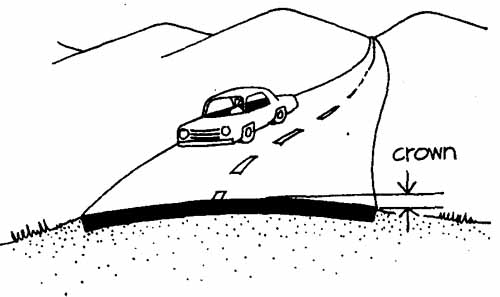When moist soil freezes, it expands slightly. Although this expansion is not severe, it's sometimes enough to crack pavings, slabs, or foundations. Much more serious damage is possible when soil moisture migrates toward the surface because of a difference in vapor pressure between the air in the pores of the soil and the free air above the surface of the ground. In cold weather, the deeper one digs, the higher the soil temperature will be. Thus moisture vapor moving upward during subfreezing weather encounters cooler and cooler soil until a level is reached at which the soil temperature is equal to the freezing point of water. Here long ice crystals form and grow vertically, pushing against the soil with enormous force as they do so. Upward soil movement of several inches (50 mm or more) is quite common under these circumstances, and pavements and foundations can be severely damaged. This phenomenon is known as frost heaving. In a foundation, it's usually prevented simply by placing the bottom of the foundation below the level to which the soil freezes in winter. With pavements, a generous layer of uniform-sized stones beneath the slab generally suffices to carry away moisture and allow for any freezing expansion. In sub-arctic climates this is not always sufficient. Pavements laid on plastic foam thermal insulation, which maintains the underlying soil temperature above freezing, are usually satisfactory.
Flat outdoor areas of any kind—roadways, tennis courts, dead- level roofs, athletic fields, sidewalks, patios—can never be made perfectly flat and planar. Because of the limitations inherent in tools, measuring devices, and materials, low spots and high spots always occur in the surface, even under the most carefully controlled conditions. This results in the accumulation of puddles during precipitation, leading to the premature deterioration of the material under the puddled areas. For this reason we seldom attempt to build a perfectly flat surface outdoors but instead introduce enough of a slope into the surface to drain the lower spots. A slope of about one in fifty, or one-fourth of an inch of drop per foot of horizontal run, is generally sufficient to leave a reasonably well made surface free of standing water. Low-slope roofs are usually pitched toward their roof drains at this slope. If a dead-level roof is attempted, however, more durable and expensive roofing materials must be used to withstand the deleterious effects of the standing water that must be expected. Symmetrical surfaces such as roadways and athletic fields are not usually sloped in a single direction but are gently crowned in the center and fall off equally toward both sides (ill. 23-12 below).
Previous: Floors and Basements Next: Interior Sources of Water
